JUST Report
Americans Say CEO Pay Is Too High: Companies Should Reduce Income Inequality by Raising Minimum Wage to Living Wage and Capping CEO Compensation
- More Reports
- View All News & Reports on Polling
- View all JUST Reports
May 9, 2022
This report was written by Jennifer Tonti, Managing Director of Survey Research & Insights.
For decades, there has been a rapidly widening gulf between our nation’s highest and lowest earners. Despite hopes that the pandemic might lead companies to hit a much-needed “reset” and orient themselves and their workers toward a more equitable trajectory, we’ve instead only seen that gulf widen.
In our 2021 Americans’ Views on Business Survey, we asked respondents what issues they believe CEOs should take a stand on, and 70% agreed that income inequality should be on their list. With research suggesting that income inequality actually slows economic growth, reducing demand by 2-4%, this is not just a moral imperative but a financial one. Furthermore, rapidly rising inflation – which will impact low-wage workers the most – creates an even stronger case for why companies need to focus in this moment on policies that lift up the average American worker, as Ford Foundation president Darren Walker recently discussed on CNBC.
And yet the wealth gap between CEOs and their workers has continued to widen. In our latest analysis of the companies in our 2022 Rankings, we found that the average CEO-to-Median-Worker Pay Ratio is 235:1 as of 2020, up from 212:1 three years prior. Specifically, average CEO pay increased 31% in the last three years while median worker pay increased only 11%, showing clearly that the hoped-for “reset” remains far from our reach.
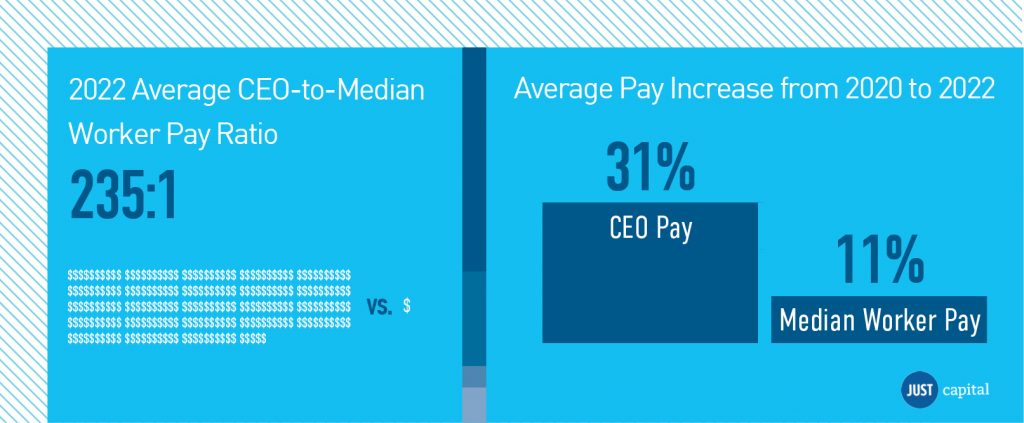
And as we look ahead, the 2022 proxy season is shaping up to be an especially active one, with CEO pay a growing investor concern. A February report from As You Sow found that opposition to excessive CEO pay has been increasing among pension and fund managers in the last few years, with packages rejected by shareholders at 16 companies – more than double those that were turned down in 2019.
An April report from Brookings investigated the state of worker pay today and found that, among the 22 companies that employ more than 7 million frontline workers, only one-third pay at least half their workers a living wage and company shareholders were rewarded five times more than workers.
While there have been positive changes in 2022 – like Verizon raising its minimum wage to $20/hour – median CEO pay nevertheless continues to grow, up to $14.2 million among S&P 500 companies, from $13.4 million the year before.
In an effort to better understand public perception on this issue – and its larger implications for America’s workforce – we worked with our polling partner SSRS to survey a representative sample of 1,037 U.S. adults, asking them whether they think CEO pay is too high or too low, what companies should be doing to narrow the CEO-to-Median Worker Pay gap, and whether they think workers are undervalued by corporate America today.
Key Findings
- The average CEO-to-Median-Worker Pay Ratio is 235:1 as of 2020, up from 212:1 in years prior. Specifically average CEO pay increased 31% in the last three years (2020-2022) while median worker pay increased only 11%.
- Industries with the highest pay gap ratios include Automobiles & Parts, Restaurants & Leisure, Household Goods & Apparel, Health Care Providers, and Internet, which tend to employ higher majorities of low-wage workers.
- Almost nine in 10 Americans (87%) agree that the growing gap between CEO pay and worker pay is a problem in this country today.
- 73% say that most CEOs of America’s largest companies are compensated too much, vs. 13% who say they are paid the “right amount.” 72% agree that companies should have CEO compensation caps, regardless of performance.
- 85% agree that one way that America’s largest companies can make a meaningful impact to reduce income inequality is by raising their minimum wage to a living wage.
- 81% of Americans believe large corporations are responsible for ensuring the basic financial security of their lowest-paid workers.
- 66% of Americans believe wage stagnation is a major problem and 80% say the recent wave of worker strikes and support for labor unions are seeking to address the fact that large corporations have undervalued workers for too long.
Read more on these findings below and to dig into these questions by demographics, explore the full report here.
Americans Say CEO Pay Is too High
We reached out to a cross-section of the American public to get a sense of how aware they are of levels of CEO pay, and whether they believe their compensation is adequate, too much, or too little for the job that chief executives do. In order to understand the degree to which the public is already informed about this subject, we split the sample into two groups, with the control group seeing only the core question (“Do you think most CEOs of America’s largest companies are compensated too much, too little, or about the right amount?”), and the experimental group who were asked the same question but also prompted with a CEO pay statistic from the Economic Policy Institute: “In 2020, the chief executive officers of the top 350 firms in the U.S. made 351 times more than a typical worker.”
Among the control group (who did not see a statistic before the core question), about three in four (73%) said most chief executive officers of America’s largest companies are compensated too much, vs. 13% who say they are paid the “right amount.”
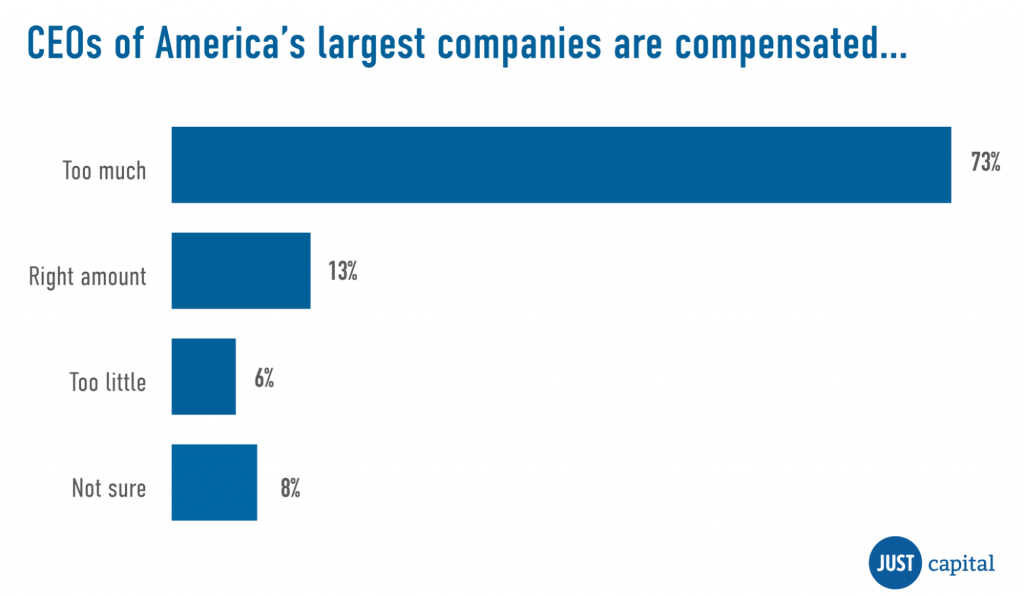 For the experimental group, who were shown the compensation ratio statistic, a slightly higher percentage said that CEOs of America’s largest companies are compensated too much (79%) vs. 10% who say they are paid the “right amount.”
For the experimental group, who were shown the compensation ratio statistic, a slightly higher percentage said that CEOs of America’s largest companies are compensated too much (79%) vs. 10% who say they are paid the “right amount.”
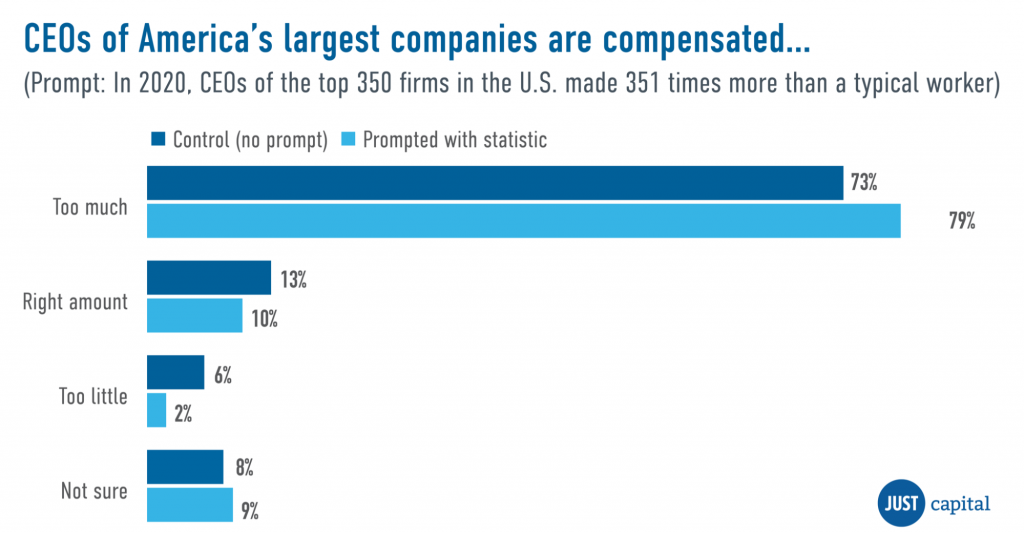
The takeaway is that, while the additional information shared with respondents does provide helpful context, the difference between the control and experimental group is negligible, suggesting that regardless of the details, Americans have a pretty solid sense that CEO compensation is unacceptably high.
Among those who align themselves with a political party, majorities in all three groups say that CEO compensation is too high, regardless of whether they were first shown a compensation ratio statistic before answering the question.
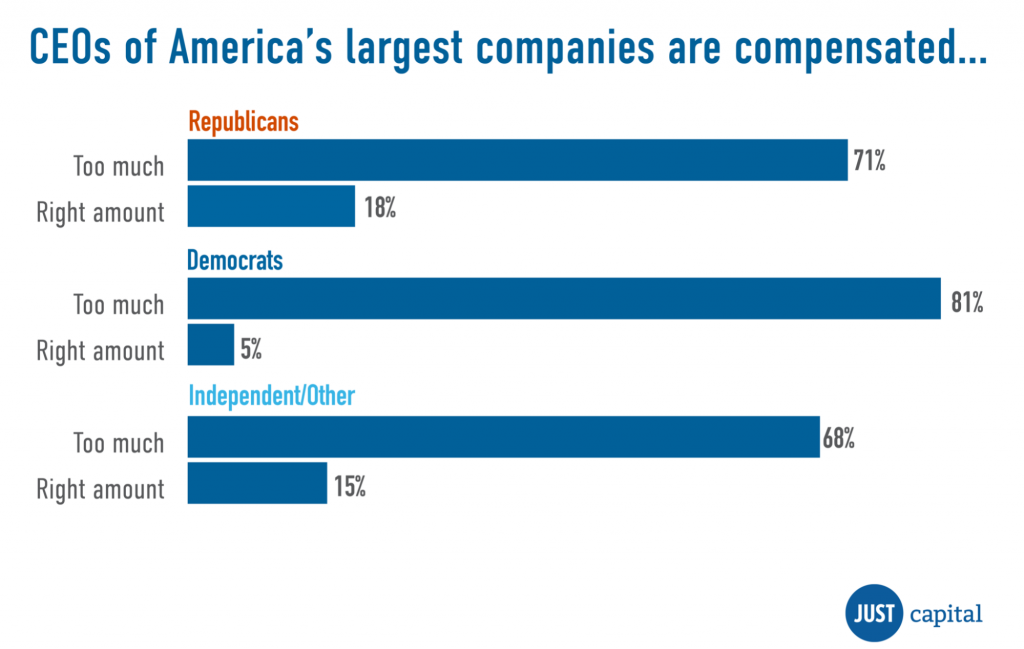
The CEO-to-Worker Pay Gap Is a Problem
In order to better understand Americans’ take on CEO pay, we asked them their level of agreement with a battery of statements about CEO compensation. A control group was just shown the statements, while an experimental group was prompted with another statistic from the EPI before answering the question: “Between 1978 and 2020, CEO compensation grew 1,322% while typical worker compensation rose by 18%.”
Again we found that both groups have remarkably similar responses, regardless of whether or not they had additional information about CEO-to-Median-Worker Pay Ratios.
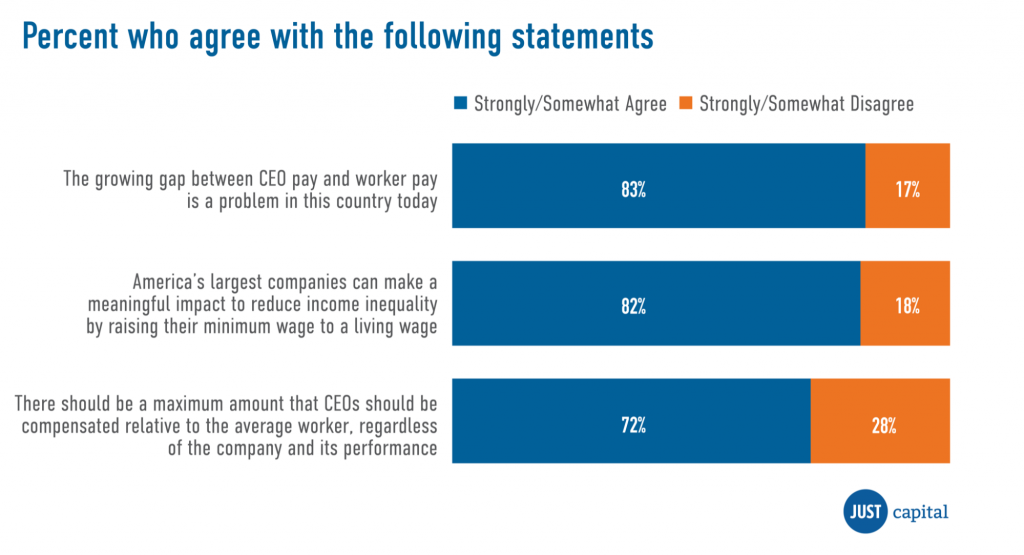
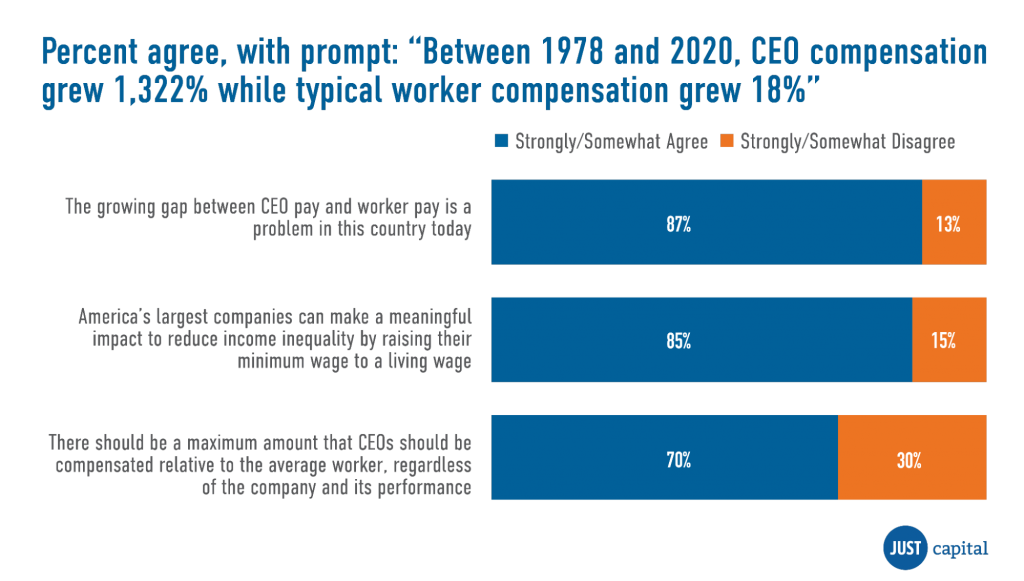
The data once again signal that Americans have an informed sense that there is a misalignment in the proportion of CEO pay in relation to low- and median-wage workers. And our own analysis reinforces their beliefs – with the CEO-to-Median-Worker Pay Ratio increasing to 235:1 as of 2020, it’s no surprise that nearly four in five Americans agree it’s a problem.
Interestingly, while our analysis showed that the average CEO pay increased 31% between 2020 and 2022, the median CEO pay only increased 4% – suggesting that pay has risen more dramatically for some. To wit: eight CEOs in the Russell 1000 were paid over $150 million in 2022, representing 10x the average CEO pay of their peers.
Furthermore, certain industries show heightened disparity – those with the highest pay gaps (averaging above 340:1 from 2020 to 2022) include Restaurant & Leisure, Healthcare Providers, and Internet, many of which employ large numbers of frontline workers. Those with the lowest pay gaps (averaging below 160:1 from 2020 to 2022) include Banks, Capital Markets, and Computer Services.
Americans Say That Companies Should Pay a Living Wage to Workers
To address these vast disparities, companies should make a significant investment in their workforces. Our polling shows that a substantial majority (81%) of Americans say that companies should do what they can to ensure their lowest paid workers have basic financial security.
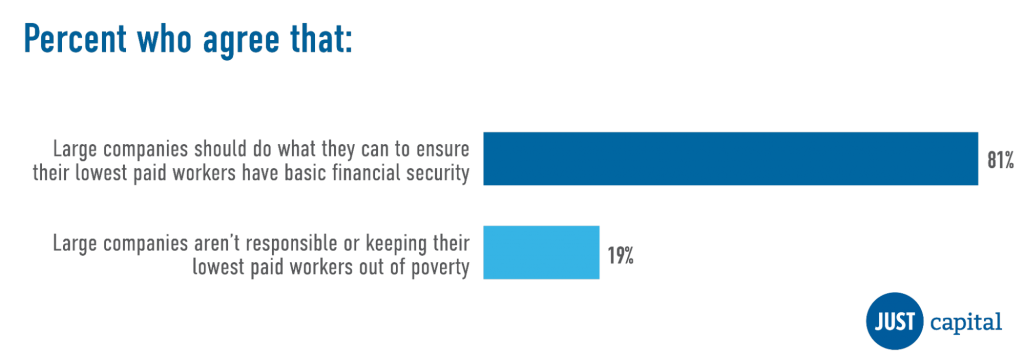
New jobs often come with bigger paychecks. A new survey from The Conference Board revealed that nearly one-third of workers who left their jobs during the pandemic are making more in their new roles. And yet, currently rising inflation rates can essentially zero out positive gains from increased wages, as paychecks lag behind rising prices – making it essential that companies pay their workers, a wage that not only covers the cost of basic needs at the local level, but solves for macroeconomic factors such as inflation.
Majorities Agree That Inequality is a Major Problem in the U.S.
To better understand their views on the severity of these issues, we asked Americans whether they believe certain national issues are significantly problematic, and found that large majorities believe that income and wealth inequality are major problems. Almost three in four say the gap between rich and poor is a major problem, and for good reason: income inequality ratios between the highest and lowest percentiles have been steadily rising over the past five decades.
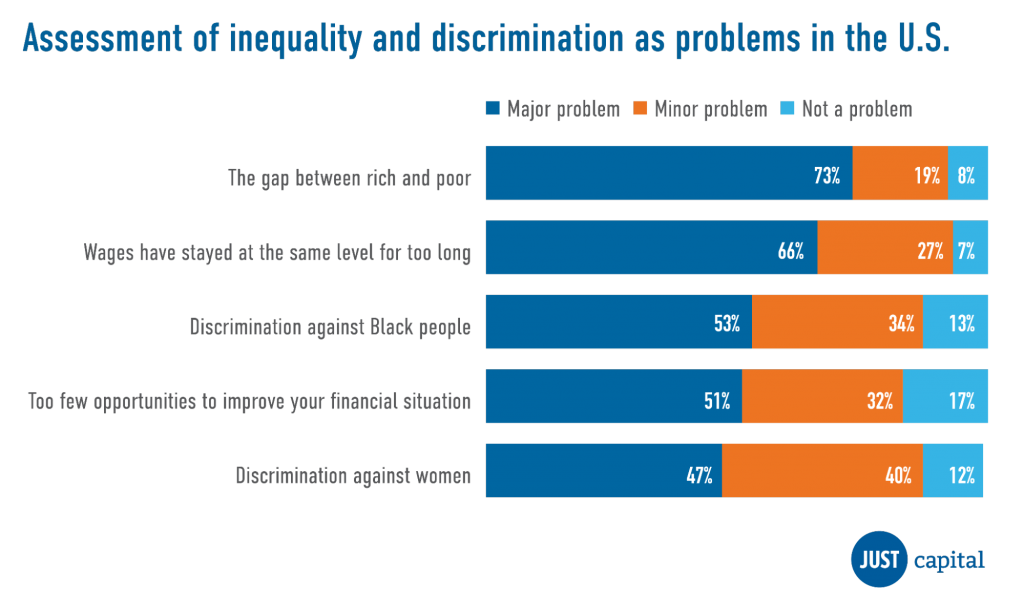
Relatedly, two in three Americans agree that wage stagnation is a major problem in our country and just over half (51%) say there aren’t enough opportunities to improve one’s individual financial situation. About half of Americans acknowledge discrimination against Black people (53%) and women (47%) as major problems as well.
The public goes on to acknowledge a general and widening economic imbalance. Roughly three-quarters of respondents (72%) say the economic system in the U.S. unfairly favors powerful interests while only 28% believe the economic system is generally fair to most Americans. In a similar vein, a large majority of Americans (78%) agree that poverty is a result of having fewer advantages in life, vs. 22% of respondents who see it as a lack of hard work.
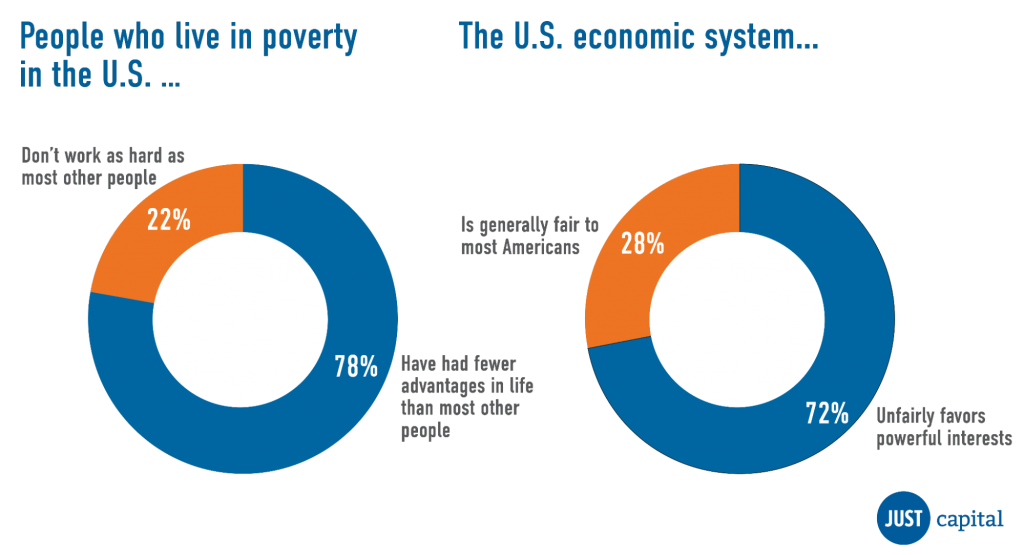
The Long-Term Impacts of the Great Resignation
Monthly quit rates continue at record highs and there are currently more job openings than there are people seeking work. But as wages remain flat despite the booming job market, it remains to be seen whether current labor market disruptions will yield better outcomes for workers in the long term. We asked the public what they anticipated, and majorities agreed that the impacts of high quit rates, low unemployment, and large numbers of open jobs will ultimately be negative for key stakeholders of the American economy – including workers overall, small businesses, and large corporations alike.
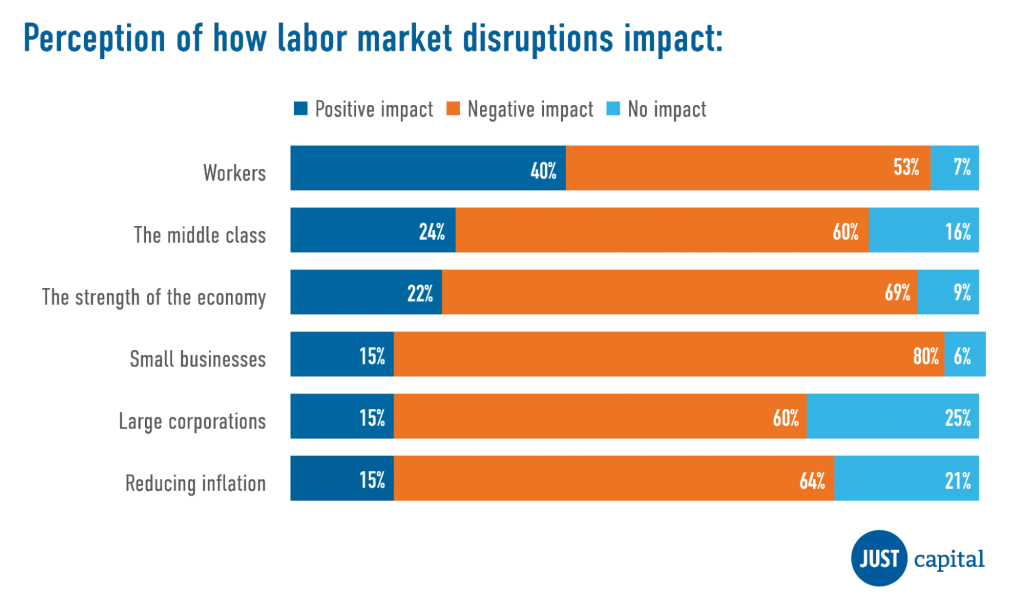
It is important to note that, although a majority of respondents agree the current labor market will have a net negative impact on workers, 40% say the impact of labor disruptions will actually be positive – suggesting that the future of workers is especially unknown.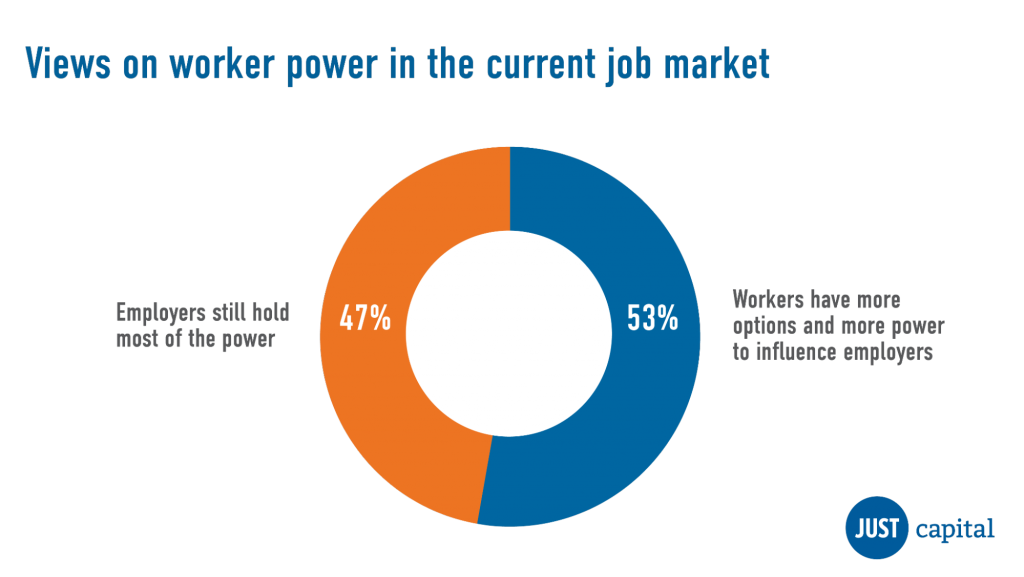
Further, Americans say companies are responsible for the current disruptions in the job market. 80% say the recent wave of strikes and unionizations are a signal that workers have been undervalued for too long.
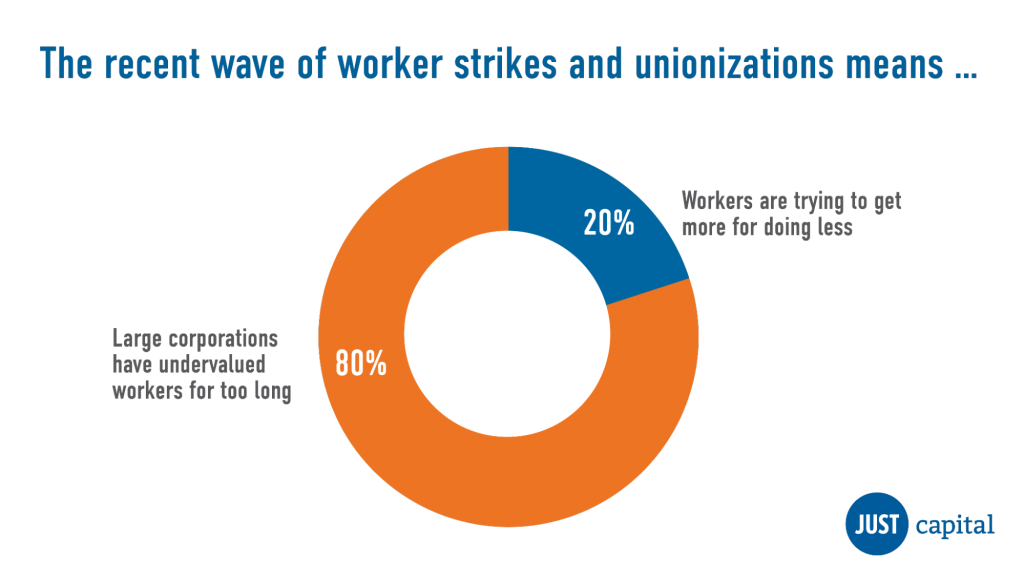
Market data from January 2022 shows that the tightened labor market does not appear to be waning: employers reported 11.3 million job openings, down a bit from December 2021 but still at record highs. Corporate leaders say it’s increasingly difficult to find and keep workers and as such have prioritized hiring and retaining talent. We asked the public their opinion about what is driving this instability: more than eight in 10 said that it is a signal that corporations need to reassess their treatment of their workers.
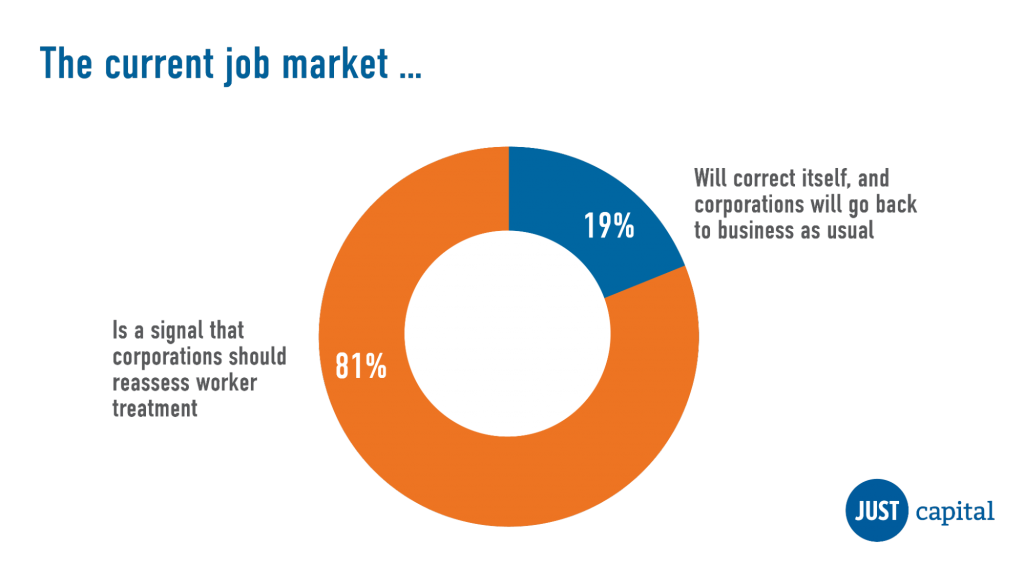
Companies Can Take Steps to Reduce Income Inequality
The message from the public is clear: responsibility lies with corporate leaders – including chief executives – to address income inequality in America today. Closing the gap requires action at the highest and lowest rungs of the corporate ladder. Ballooning CEO wages should be curbed, yes, but these measures won’t matter unless worker wages and employee financial health become a priority for C-suite leaders – something we provided key guidance around through our Worker Financial Wellness Initiative. Ensuring that our nation’s lowest-paid workers are able to cover their basic costs of living is an essential step toward addressing income inequality, and Americans clearly agree that companies can play a part by raising their minimum wages to a living wage.
CEO compensation must also be addressed. Companies can generously compensate their leadership while providing a cap for CEO pay that limits the stratospheric growth of C-suite compensation while potentially resulting in positive downstream effects for workers should those wages be redistributed amongst the workforce.
A recent study from the Financial Times showed that capping CEO compensation could help lift low-wage workers out of financial insecurity. Playing out a hypothetical scenario in which 110 of the largest, publicly traded U.S. companies capped their CEO wages at $1 million, the FT found that workers at these companies could receive an extra $400/month – an amount the Federal Reserve has said more than one-third of Americans could not cover if an unexpected bill came up.
Finally, tying CEO compensation to stakeholder-focused outcomes is a growing movement among corporate boards of some of America’s largest companies. Starbucks, for example, recently joined Apple and Disney in tying executive pay to ESG targets, such as retaining workers of color and reducing greenhouse gas emissions. An analysis by ISS shows that since 2018 there has been a three-fold increase in the number of Russell 3000 companies that tie executive compensation to corporate social responsibility metrics.
With consumers, investors, and the American public writ large all growing frustrated with skyrocketing CEO compensation packages, this model is a way of rewarding CEOs for better serving their stakeholders – including their workers – or holding them accountable when they do not. It represents a key step, along with prioritizing worker financial security, in addressing wage inequality and building a more just and equitable economy for all Americans.
To dig into findings more – including perspectives on these questions by demographics – explore the full report here.
Methodology
This survey was conducted online within the United States by SSRS on behalf of JUST Capital, and was fielded between February 4 and February 7, 2022. SSRS interviewed a representative sample of 1,037 U.S. adults (age 18 or older) for this survey from among its online Opinion Panel, a nationally representative, geographically diverse and probability-based web panel reaching respondents in all 50 states.
The margin of error is +/- 4% at a 95% confidence level. Results were weighted to U.S. Census parameters for age, gender, education, race, Hispanic ethnicity, Census Division, and specifically surrounding party identification in order to ensure representativeness of the U.S. population. All margins of error include “design effects” to adjust for the effects of weighting. For complete survey methodology, including weighting variables and subgroup sample sizes, please contact jtonti@justcapital.com.